The guardians of the Himalayas
Sherpa Heritage Trail
The Sherpa Heritage Trail lets you dive deep into the culture of the world’s most legendary mountain people, the Sherpas. The breathtaking trekking off the beaten track in the Mt. Everest area is enhanced by inspiring encounters, from yak herders to Mt. Everest conquerors to the peasant women of the enchanting village of Chaurikharka.
Offer
Sherpa Heritage Trail, Nepal
Private trekking with deep insights into the culture of the Sherpas
Dates: daily bookable between 25.03. – 15.05. and 15.09. – 15.11.
Price from € 1.998,- p. p.
Key facts
Character: Individual trekking tour with deep insights into the culture of the Sherpas in the Everest region in Nepal
Country: Nepal, Khumbu/Sagarmatha National Park Region
Level: ●●●○○
Contribution: financial support to “Sagarmatha Next” to solve the garbage problem in Khumbu
Travel guide: TAAN certified Sherpa guide with good English skills
Included services: a.o. accommodation in hotels, lodges & homestays with full board on the trek, luggage service, shuttle services & English speaking tour guide
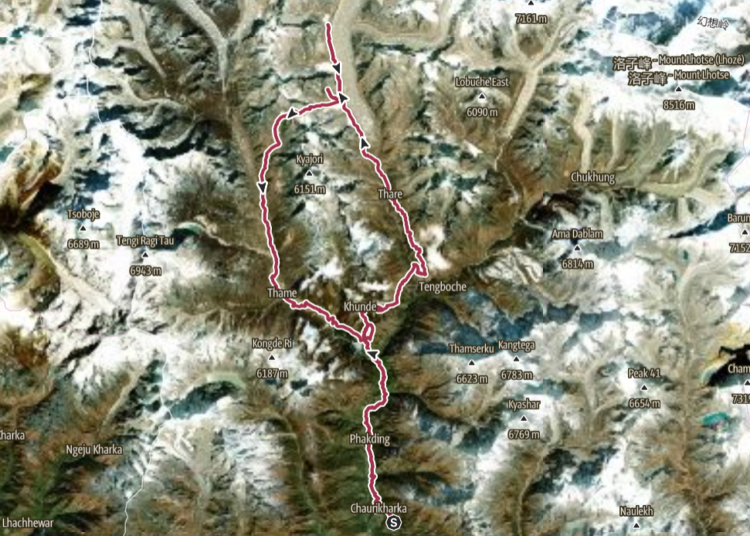
©Google Maps®/Trail Angels
The guardians of the Himalayas
1. The journey
Character of the journey
Khumbu – the roof of the world. Home of the highest mountains of our beautiful planet and home of probably the most famous mountain people in the world: the Sherpa. Especially the 8,848 m high Mount Everest has made this formerly extremely remote mountain region one of the most sought-after destinations for hikers and mountaineers.
And certainly rightly so: there will hardly be a traveler whose mouth did not drop open at the first sight of Mount Everest and all the other six-, seven- and eight-thousanders. In addition, there is a cultural heritage that will accompany and fascinate you throughout your journey: Buddhism characterizes the life of the Sherpa and is visible at almost every corner. Just think of the Buddhist flags hanging everywhere, the gompas with their monks and the chortens in every village. Together with the hospitality of the Sherpa people, the result is an almost irresistible total package for cosmopolitan outdoor enthusiasts, namely the Sherpa Heritage Trail, which you can book as a “Private Trekking” individually at any time within the trekking seasons, and that already from two persons.
.
In the “Sherpa Heritage Trail” not only the landscape, but especially the life of the Sherpas is central theme. You are on the road with them and take part in everyday life and culture very closely. Discuss with them how they farm or what significance the yak has in one of the highest inhabited regions on earth. You will travel off the beaten track and be guests of Sherpa families – and always accompanied by Pemba Sherpa, your guide and Sherpa expert from Chaurikharka. If you travel back with the feeling that the region has so much more to offer than “just” Mount Everest, then we have reached our goal!
The Sherpa Heritage Trail through the Khumbu region in the heart of the Himalayas begins in Kathmandu, as do all trips to Nepal. Here you have time at the beginning of the trip to get to know the two philosophies that determine life in Nepal, Hinduism and Buddhism, and also to make your first contacts with the Sherpa people. And: Yes, Kathmandu is a culture shock for most people who don’t know the city yet. At least if you see the word as a synonym for traditions, ways of life, culinary and the like unknown to us. And the capital of Kathmandu has more than enough of that to offer, so you will certainly forget your everyday life immediately.
.
Then it starts early in the morning: a spectacular flight in a small plane takes you to Lukla, the “gateway” to the Khumbu and notorious for the exposed location of the airport. Your trekking already begins: you hike briefly on the much-traveled Everest trek, but soon turn off behind Lukla to Chaurikharka. A quiet contemplative place away from the tourist crowds, which, however, has a very special meaning for us Trail Angels: years of deep friendships have forged strong bonds between us and the place – for example, a Sherpa from this village is firmly integrated into the family of trail expert Stefan and lives with her in Austria.
.
Chaurikharka will accompany you, by the way, in a way on your whole trek on the Sherpa Heritage Trail, since both guide and porters and your local contact Nawang come from this place. So you will continue towards Phakding (here you will visit a remote monastery) and Namche Bazar: you will hike partly on unknown trails, but in this section often also on the popular main trek towards Mount Everest. It is like a shock of civilization, but this is also an inseparable part of today’s Khumbu. The scenery becomes increasingly spectacular: wild gorges are traversed, suspension bridges crossed, and more glaciated giants line your path.
Namche Bazar clings to the steep slopes like a bird’s nest and is surely the center of the Khumbu: trading post, hub of the valleys leading down from the glacier giants. In this – one would almost say – city you will get everything your heart desires for the last time. You will stay here for two nights because Namche Bazar is already at 3,440 meters and you need to be well acclimatized to continue the ascent. You will visit the information center of our impact partner Sagarmatha Next and learn a lot about the difficulties of life in the Khumbu and their possible solutions.
Above Namche, you will see the 8,848-meter Mount Everest for the first time. You leave here, however, again the much-traveled Everest Basecamp Trek and hike via Khumjung to Phortse. Here you finally turn off and no longer hike in the direction of Mount Everest, but through a wild, largely untouched valley via the pastoral settlement of Nha to Gokyo at the foot of the 8,201 m high Cho Oyu.
Gokyo occupies a special position: the 4,750 m high and located on the third Gokyo Lake is the only settlement that has not been inhabited for centuries. The location on the Ngozumpa glacier – the largest ice stream in Nepal – is too barren and exposed for that. A fantastic location in the middle of the highest mountains in the world. From here you can reach the 5,357 m trekking peak Gokyo Ri via a strenuous but easy climb. A true viewing platform above the Ngozumpa Glacier with views of four eight-thousanders and countless six- and seven-thousanders all the way into Tibet.
After 2 nights, you will leave the valley and descend into the neighboring valley via the 5,417-meter Renjo La. With the crossing of this pass you have reached the highest point and an absolute highlight of your trip. Through a lonely valley you will descend to the rarely visited shepherd settlement Lungden. Now you let the trekking slowly come to an end: in three days you hike down via Thame (with a visit to the famous monastery) and close the circle of your trekking round again in Namche Bazar. You already know the following way to Lukla. Before you fly back to Kathmandu by plane, you will pay a farewell visit to Chaurikharka. Maybe you feel like us after all the eventful days with your friends from Chaurikharka: a visit to old friends. One would not even like to talk about farewell, because we are sure: also you will not have been the last time in Chaurikharka!
Back in Kathmandu you still have time to enjoy this breathtaking city before heading back home.
Highlights of the journey
Travel itinerary*
| Day 1 | Arrival: Arrival in Kathmandu; accommodation: hotel |
| Day 2 | Culture: Buddhism sightseeing tour Kathmandu; accommodation: hotel |
| Day 3 |
Transfer & Trekking: Flight Kathmandu – Lukla; Stage 01 Lukla – Phakding (2,610 m) on side trails; accommodation: lodge Walking time: 4 h → 10 km 387 m ↘ 633 m Flight time: 1 h |
| Day 4 |
Trekking: Stage 02 Phakding – Namche Bazar (3,440 m); accommodation: lodge Walking time: 5 h → 9.9 km 900 m ↘ 110 m |
| Day 5 |
Day 5 | Acclimatization day: Hike to the visitor center “Sagarmatha Next”; sherpa culture; accommodation: lodge Walking time: 3 h → 5.2 km 450 m ↘ 450 m |
| Day 6 |
Trekking & culture: Stage 03 Namche Bazar – Khumjung (3,790 m); program “a day with a Sherpa family”; accommodation: homestay Walking time: 2 h → 2.9 km 428 m ↘ 74 m |
| Day 7 |
Trekking & culture: Stage 04 Khumjung – Phortse (3,840 m); program “Sherpas and the eight-thousanders”; accommodation: homestay Walking time: 4 h → 6.9 km 579 m ↘ 552 m |
| Day 8 |
Trekking: Stage 05 Phortse – Nha (4,400 m) on side trails; accommodation: homestay Walking time: 5,5 h → 10,6 km 850 m ↘ 250 m |
| Day 9 |
Trekking: Stage 06 Nha – Gokyo (4,750 m); summit tour Gokyo Ri (5,357 m) for sunset; accommodation: lodge Walking time: 6 h → 8.8 km 979 m ↘ 605 m |
| Day 10 |
Trekking: Stage 07 Gokyo – Ngozumpa Tsho (4,980 m) – Gokyo; accommodation: lodge Walking time: 4,5 h → 11,7 km 255 m ↘ 255 m |
| Day 11 |
Trekking: Stage 08 Gokyo – Renjo La (5,417 m) – Lungden (4,350 m); accommodation: homestay Walking time: 4 h → 11.4 km 730 m ↘ 1,100 m |
| Day 12 |
Trekking & culture: Stage 09 Lungden – Thame (3,800 m); visit Thame Monastery; accommodation: lodge Walking time: 3 h → 10.6 km 144 m ↘ 711 m |
| Day 13 |
Trekking: Stage 10 Thame – Monjo (2,830 m); accommodation: lodge Walking time: 5 h → 14.1 km 150 m ↘ 1,150 m |
| Day 14 |
Trekking & culture: Stage 11 Monjo – Chaurikharka – Lukla (2,850 m); program “Meeting of the village community of Chaurikharka”; accommodation: lodge Walking time: 5 h → 13.5 km 450 m ↘ 400 m |
| Day 15 |
Transfer & rest: Flight Lukla – Kathmandu; rest in Kathmandu (free time); accommodation: hotel Flight time: 1 h |
| Day 16 | Culture/rest: Recreation day Kathmandu (optional with extra charge cultural program Kathmandu); accommodation: hotel |
| Day 17 | Departure: Return flight from Kathmandu |
*small program changes reserved
Included services
| + | 4 nights in selected middle class hotels (***/**** national categorization); double room with breakfast |
| + | 12 nights in family-run lodges; double or shared rooms with full board |
| + | Guided tour by experienced Sherpa guide (TAAN certified) with knowledge of the area; also expert on Sherpa culture |
| + | From the 5th guest one assistant guide |
| + | Porter for luggage transport (max. 15 kg p.p.) |
| + | Guided tour through visitor center of Sagarmatha Next as well as some organized meetings with interesting Sherpas |
| + | Guided cultural tour of Kathmandu (UNESCO World Heritage Site) |
| + | All necessary transfers (airport shuttles, cultural tour Kathmandu) |
| + | Domestic flights Kathmandu – Lukla and back |
| + | Trekkingpermit and protected area entrance fee |
| + | Contribution for Sagarmatha Next to solve the garbage problem |
| + | Contribution for climate neutrality (incl. certificate) |
| + | Detailed tour documents (incl. trekking map) |
| + | Before the trip: Info service by Himalaya experts |
| + | On the trek: Trekking Hotline 24 hours * 7 days |
Price from € 1.998,- p. p.
Bookable from 2 persons
Our experts at the Sherpa Heritage Trail
2. The pioneers
Meet our Sherpa Heritage Trail pioneers who will accompany you on your trekking trip on the Sherpa Heritage Trail and give you many insights into the region, culture and the exciting projects on the Sherpa Heritage Trail:
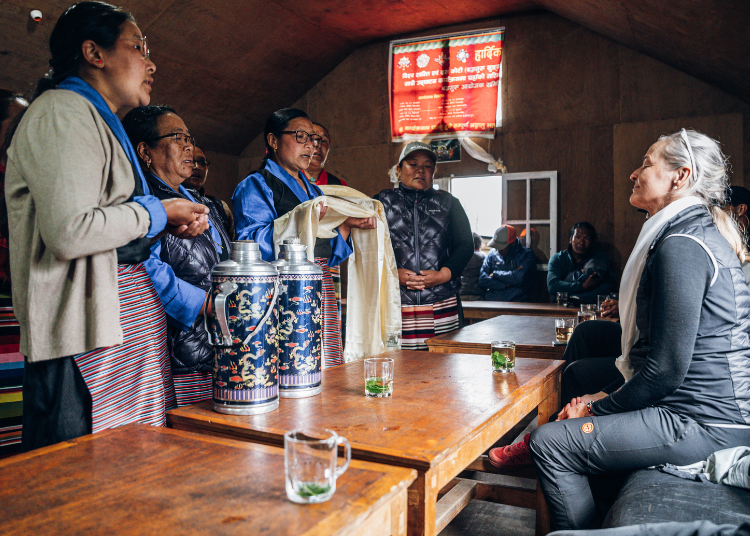
Chaurikharka village community
The Sherpa Heritage Trail lives next to the outstanding landscape from the encounters with the Sherpas. Many encounters can not be planned and should not be – but we leave room for it on the trip. Some particularly interesting Sherpas …
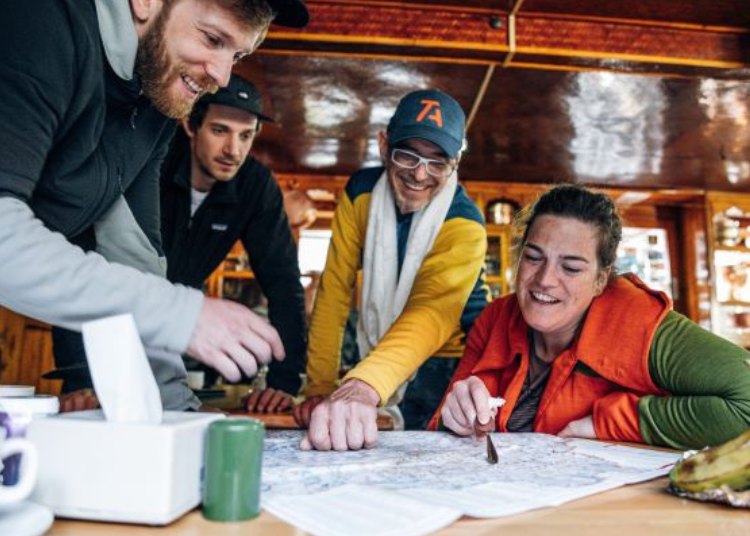
Stefan Lieb-Lind,
IVBV mountain & ski guide
The state-certified mountain and ski guide Stefan Lieb-Lind is the discovery in the blood: So he has not only with more than 100 first ascents in rock and ice in the Western Balkans, the Alps, Iran and Bolivia in climbing circles made a name for himself, but is also in the course of his work …
Even though you won’t be traveling with Stefan Lieb-Lind in Nepal – the Sherpa Heritage Trail is offered as a “private trekking” only with local guides – you will still have to deal with him in the run-up to your trip, as he has played a leading role in developing the Sherpa Heritage Trail and knows it like the back of his hand. He will advise you in all questions you have about the trip, so that you can travel to Nepal well prepared.
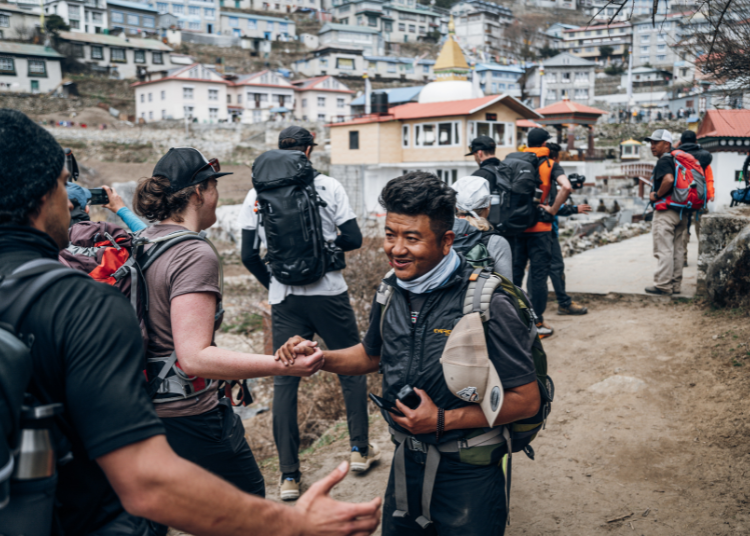
Pemba Sherpa,
the local insider
Pemba Sherpa is unique: not to see him in a good mood is almost impossible. The guide from Chaurikharka fulfills two functions on your trekking trip: on the one hand he is of course a guide, and a damn good one at that. With the experience of many guided trekking tours …
On the other hand, he is an absolute expert on Sherpa culture. It helps him both as a guide and as a Sherpa expert that he also knows the Western culture very well. So he already knows intuitively what can be interesting for you, and leads you both technically and locally exactly there.
Travel with impact for change
3. Our impact
Trail Angels tries to live up to its responsibility as a tour operator for the travel of the future. By opening up breathtaking experiences with handpicked tours and with participation in regional projects and measures for climate protection, we want to trigger the greatest possible impact for a change for the better in the destinations.
And that’s how we frame our responsibilities on the Sherpa Heritage Trail:
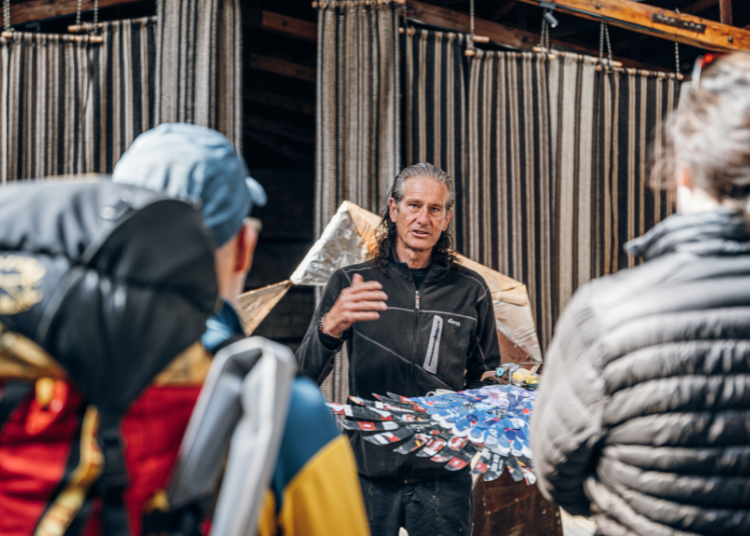
1. Trail Angels project
Financial support “Sagarmatha Next” to solve the garbage problem in Khumbu:
We don’t need to mention anymore that the Khumbu is outstandingly scenic.
“Sagarmatha Next” is an NGO dedicated to addressing the complex issue of garbage in the Khumbu. It works in the following areas:
- Raising awareness of the issue among both locals and tourists
- Concrete and clever measures for the removal of waste (“Carry Me Back”)
- Initiatives to reduce waste and even recycle on site
Sagarmatha Next was co-founded by Tommy Gustafsson, who works together with other international as well as national experts and enthusiasts on the successful implementation of the ideas. You will have the opportunity to visit the very interesting information center above Namche Bazar.
We think: “Sagarmatha Next” is based on a very sensible concept that addresses an urgent problem in the Khumbu very cleverly and efficiently. Therefore, we support this initiative very gladly and give 4% of your travel price directly to “Sagarmatha Next”. This amount is used to pay porters who carry garbage out to Lukla – for the benefit of the hard working porters and a clean landscape.
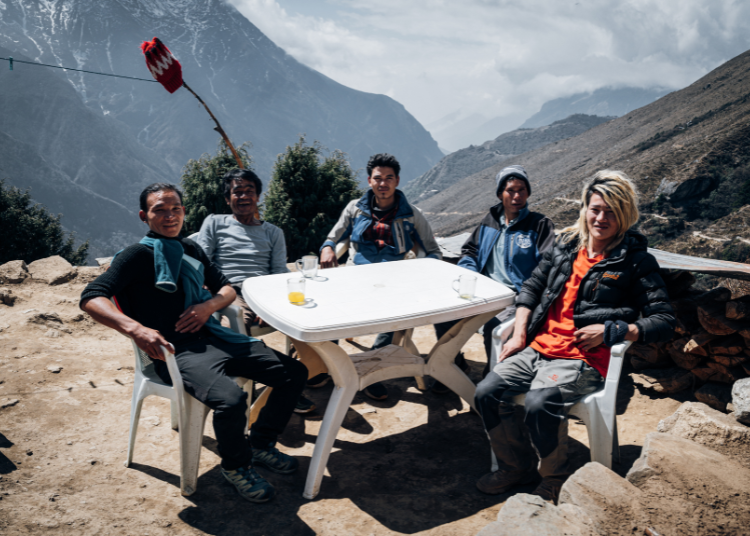
2. Social inclusion
Promotion of local structures
We work exclusively with carefully selected and vetted local tour providers and place the highest value on social sustainability …
- Fair payment for trekking crew
- On the trek: Overnight in small family-run guesthouses or in private mountain huts
- Promotion of socially disadvantaged population groups and local value chains
To this end, we are involved in a three-year project together with the Gesellschaft für Internationale Zusammenarbeit (GIZ) and local experts, ourselves very intensively and in a prominent position, with the development of the High Scardus Trail as a leading tourist product for the sustainable development of mountain regions.
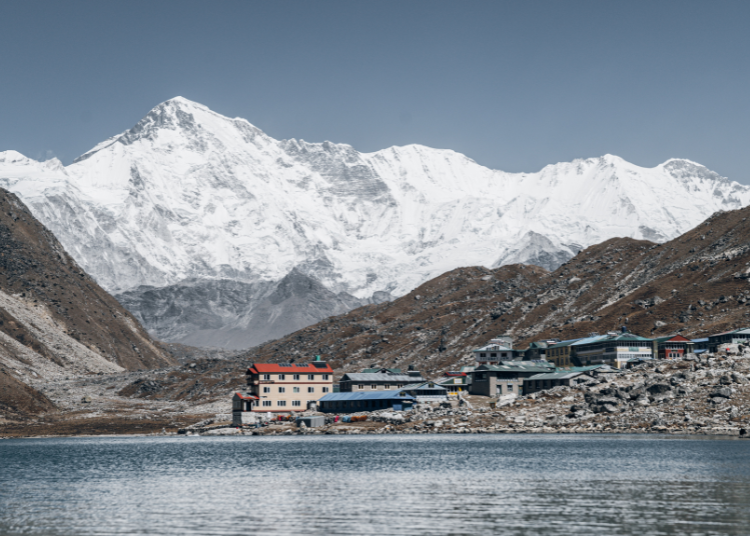
3. Climate protection
Climate-neutral design
If you want to organise your trekking trip in a climate-neutral way, you can do so with the world’s leading offsetting platform Atmosfair®. Our team in the booking centre will be happy to help you.
The guardians of the Himalayas
4. The story
The Sherpas are certainly the most famous mountain people in the world. Pictures of Sherpas leading customers to one of the most hostile points in the world, the summit of Mount Everest, have gone around the world. And the saying “I am not your Sherpa” has probably been heard by everyone. A sign of how well known the Sherpas are – but also a sign of how little we know about the people. The word “Sherpa” means neither “Nepalese mountaineer” nor “porter”; but is – as already mentioned – one of the many Nepalese peoples. The people who live in the Khumbu region in one of the highest populated regions on earth around Mount Everest, Lhotse and Cho Oyu.
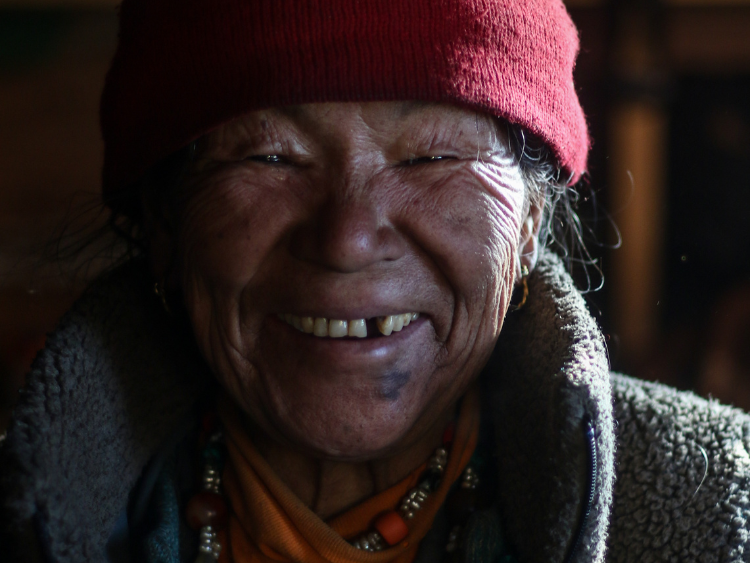
Alongside the scenic attractions, the interpersonal encounters are what the Sherpa Heritage Trail is all about © Anuj Adhikari

Back to school again: The daughter of our host in Khumjung explains everyday school life in the Khumbu to us during our school visit © Max Mauthner/Trail Angels
The region was extremely remote until the start of tourist interest. The Sherpas – like any mountain people – had adapted perfectly to the remoteness and the harsh and barren local conditions. They were farmers and lived from trading over the passes of the Himalayas. Life was strongly influenced by Buddhism, as evidenced by the many gompas and chörts.
This life is still visible today. But of course, tourism and better accessibility, especially through the adventurous airport in Lukla, has changed the lives of the Sherpas. More so in places along the famous trekking routes, and much less so in more remote villages. Along the famous trekking routes, many Sherpas work as guides or in lodges, others pursue their farming life. Many Sherpas also spend part of their lives abroad – outside the Khumbu, the second most Sherpas are found in New York.

With family connection: During the trek you will always stay in small homestays or lodges that are as familiar as possible © Max Mauthner/Trail Angels

Mutual understanding: A guest tries to carry the load of our porters for a few metres – the porters laugh their heads off and we laugh with them © Max Mauthner/Trail Angels
This is how the Sherpas have learned to master the balancing act between tradition and change. On the Sherpa Heritage Trail, accompanied by your Sherpa expert Pemba Sherpa, you can gain a deep insight into the life of the Sherpas between tradition and modernity – away from and also in the middle of the famous trekking trails. For example, you will spend a few moments at the school in Khumjung under the guidance of a student, talk to yak herders and learn about the meagre possibilities of farming at 4,000 m above sea level. You have the opportunity to interview Sherpas who have stood on the summit of Mount Everest several times and talk to the initiators of “Sagarmatha Next”, who have dedicated themselves to solving the problem of waste. Perhaps you can help out in the kitchen of a homestay and be full of admiration for the humble means with which dreamlike dishes are conjured up. You will visit monasteries and, if you are lucky, get an audience with the Rinpoche of Thame. In Chaurikharka at the end of your trek you will have the feeling of saying goodbye to a family.
In short, we bet you will be so impressed that you will take a part of the Khumbu home with you in your heart. Goodbye – we’ll see you again!
Travel reports from the Sherpa Heritage Trail:
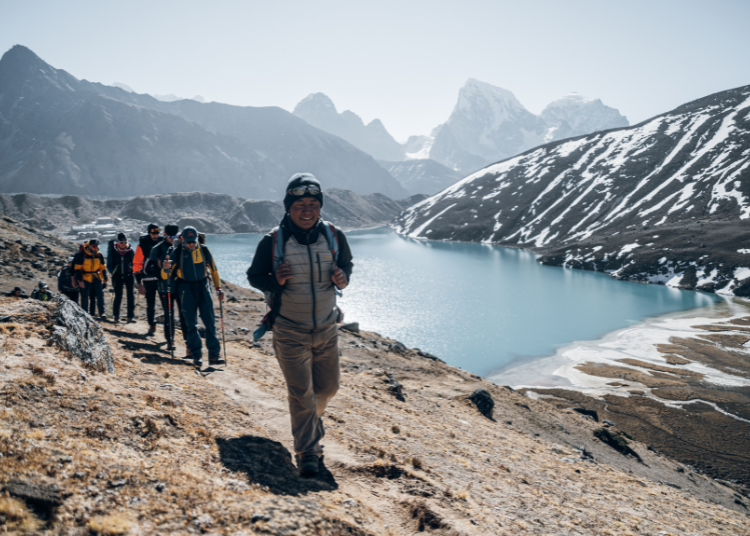
Explorer Tour Sherpa Heritage Trail: A Review
A very personal travelogue from our Trail Insider Stefan Lieb-Lind.
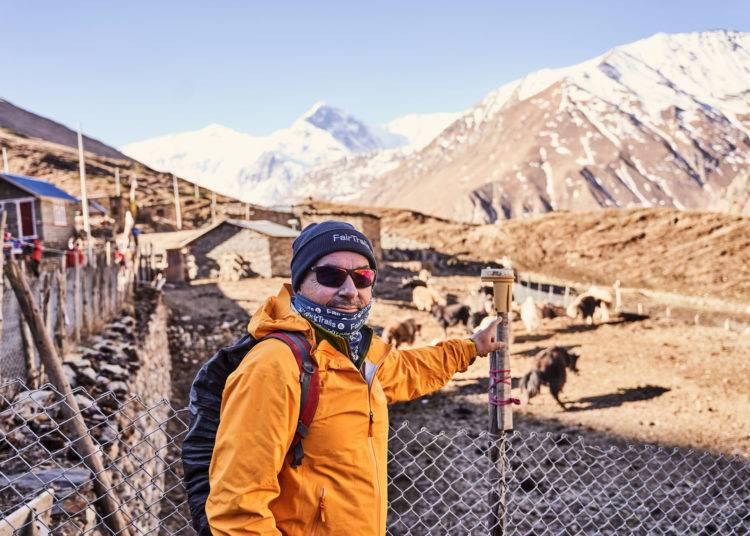
The future in outdoor tourism explained by CEO Günter Mussnig
CEO Günter Mussnig in an interview with Sportaktiv magazine about trend developments and opportunities in outdoor tourism.
Trail Angels Newsletter
Want to be kept up to date on our Trail Angels trips?
FOLLOW US








